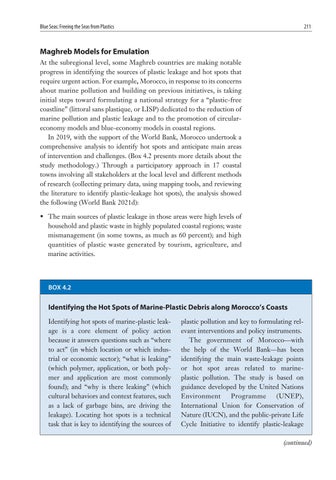Blue Seas: Freeing the Seas from Plastics
211
Maghreb Models for Emulation At the subregional level, some Maghreb countries are making notable progress in identifying the sources of plastic leakage and hot spots that require urgent action. For example, Morocco, in response to its concerns about marine pollution and building on previous initiatives, is taking initial steps toward formulating a national strategy for a “plastic-free coastline” (littoral sans plastique, or LISP) dedicated to the reduction of marine pollution and plastic leakage and to the promotion of circulareconomy models and blue-economy models in coastal regions. In 2019, with the support of the World Bank, Morocco undertook a comprehensive analysis to identify hot spots and anticipate main areas of intervention and challenges. (Box 4.2 presents more details about the study methodology.) Through a participatory approach in 17 coastal towns involving all stakeholders at the local level and different methods of research (collecting primary data, using mapping tools, and reviewing the literature to identify plastic-leakage hot spots), the analysis showed the following (World Bank 2021d): • The main sources of plastic leakage in those areas were high levels of household and plastic waste in highly populated coastal regions; waste mismanagement (in some towns, as much as 60 percent); and high quantities of plastic waste generated by tourism, agriculture, and marine activities.
BOX 4.2
Identifying the Hot Spots of Marine-Plastic Debris along Morocco’s Coasts Identifying hot spots of marine-plastic leakage is a core element of policy action because it answers questions such as “where to act” (in which location or which industrial or economic sector); “what is leaking” (which polymer, application, or both polymer and application are most commonly found); and “why is there leaking” (which cultural behaviors and context features, such as a lack of garbage bins, are driving the leakage). Locating hot spots is a technical task that is key to identifying the sources of
plastic pollution and key to formulating relevant interventions and policy instruments. The government of Morocco—with the help of the World Bank—has been identifying the main waste-leakage points or hot spot areas related to marineplastic pollution. The study is based on guidance developed by the United Nations Environment Programme (UNEP), International Union for Conservation of Nature (IUCN), and the public-private Life Cycle Initiative to identify plastic-leakage (continued)






